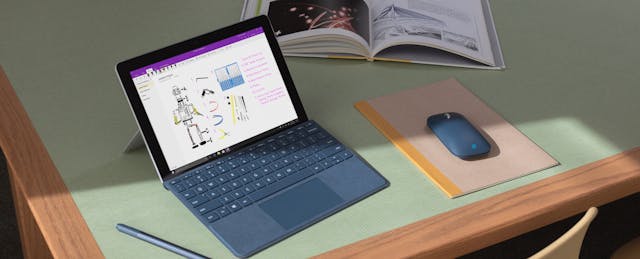For much of this decade, the narrative of tech giants battling to sell devices in U.S. K-12 classrooms has pitted Apple against Google. But through an ongoing series of product launches and acquisitions, Microsoft has been making its case to be the dark horse in the race.
Today, the Redmond, Wash.-based company continued its streak of education announcements with the launch of the Surface Go, a version of the hybrid tablet that Microsoft aims to sell to schools. Measuring 10 inches (diagonal) and weighing 1.15 pounds, the Surface Go is the latest addition to a growing portfolio of education devices from Microsoft.
The base model, which will run either Windows 10 Home S or Windows Pro, starts at $399, and comes with 4GB of RAM and 64 GB of storage. Bulk purchase discounts will be available on a case-by-case basis. Extra accessories available for purchase include a keyboard that doubles as a device cover (which costs either $99 or $129, depending on the model) and a mouse (available for $34.99).
The Surface Go’s demographic “sweet spot” are students in grades 3-5, says Microsoft Education’s senior communications manager Annie Arnold in an interview. “A very simplistic mobile device that works for your first-grader,” she claims, “isn’t going to work for older students who need a little bit more functionality.”
That target age range seems accurate, at least based on how compact the device feels. By adult standards, it feels small. In an unmarked warehouse in San Francisco last month, Microsoft representatives offered a peek at the Surface Go. As seen in the photo below, it was quite a stretch for my right pinky to hit the ‘p’ key.

Admittedly, the keyboard was likely not designed for adult hands.
Currently, the cheapest Surface available is $799—a prohibitive cost for most schools and districts. This latest model, at half the price, marks “a big move in terms of making the Surface family more accessible in education,” says Arnold.
Yet at $399, the price tag is still higher than the Surface Go’s main rivals. Apple’s new iPad debuted earlier this March and retails at $299 for education purchasers. That same month, Google announced that it was working with Acer to create an education tablet made for Chrome OS, which starts at $329.
Resurfacing the Microsoft’s Education Effort
The education tablet was once the domain of Apple, whose iPads won headlines and statewide adoptions at the start of this decade. Microsoft’s efforts to compete in this space did not start well. One of the earliest incarnations of the Surface line, the Surface RT, fared poorly. (So much that the company gave away 10,000 of those devices for free at an education technology conference in 2013.)
Then came Google’s Chromebooks, which quickly became the device of choice for many K-12 education buyers in the U.S. Microsoft decided to compete with these new devices on cost, triggering a price war that saw both companies drop the sticker tag for their devices below $200. Today, Microsoft’s Windows 10 laptops start at $189 for education users. (These entry-model laptops don’t have the same touchscreen functionality as the Surface Go.)
Since 2013, Google Chromebooks continued to grow their market share in U.S. education at the expense of Apple and Microsoft, as shown by the data below from market research firm Futuresource. Microsoft saw a staggering drop from 2012, and for the past three years its share of the U.S. K-12 market has hovered around 22 percent. (It’s a different story in the rest of the world, however, where Windows dominates. And for devices that cost below $300, Microsoft’s share of the U.S. market has grown for eight consecutive quarters, according to the paywalled report.)

By itself, the new tablet is unlikely to dramatically swing the U.S. K-12 device market for Microsoft, says Ben Davis, a senior analyst at Futuresource. Despite their declining market share, Apple’s iPads still have the upper hand due to a “strong ecosystem of app partners” and a higher resale value in the second-hand market, he tells EdSurge.
What is more likely to sway district buyers are productivity and collaborative software that make the hardware useful. On this front Davis says that Microsoft has been investing in the same types of solutions as Google, including tools that help administrators control school user accounts, and new communication and classwork management tools. In recent years, Microsoft has also added features to make its tools more accessible to learners with disabilities.
Outshadowed by Apple and Google over the years, Microsoft has also been eager to catch up through a slew of acquisitions. So far this year, Microsoft has bought Chalkup, a classroom management software, and is integrating its features into an education version of Microsoft Teams, a group collaboration tool. Last month the company also purchased Flipgrid, a popular video-discussion platform that its creators claims has been used more than 20 million students and teachers.
At an event last May where the company unveiled a suite of educational tools, Microsoft’s CEO Satya Nadella affirmed that capturing the school market will be a core focus for the company. “Democratizing education must be something that is for everyone and not just for a select few,” he said. “This is something that is deeply personal.”
Microsoft’s attention to education has not gone unnoticed. “Under Satya [Nadella, the company’s CEO], there’s been more of a focus on developing products for education, rather than giving schools discounts,” says Kurt Madden, chief technology officer at Fresno Unified School District in California.
Fresno Unified, which serves roughly 74,000 students, currently has approximately 76,000 Microsoft devices deployed for students and teachers. Madden says the district has stuck with Windows for more than a decade, and has resisted the temptation to switch even as iPads and Chromebooks ascended in turn to become device du jour. “We chose Microsoft and kept to it,” he says, “since as a district it’s difficult to support even two different tech ecosystems.”
“Are there other platforms that may be a little better? Maybe,” Madden adds. “But if you have too many operational systems, you can cause some chaos when you try to support and keep up with them all.”
But that same mindset could also prove an obstacle for Microsoft’s efforts to woo districts from its competitors.
“Change is hard,” Madden warns, “and it’s tough for districts to survive a big technology conversion.”


